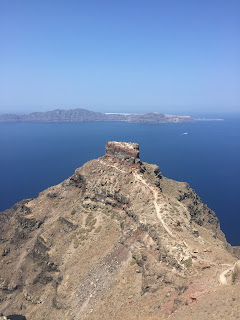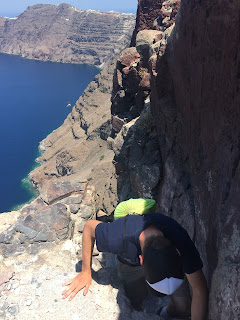The following is the first of at least two expansions on a short report that I wrote to fulfill my obligations to the UChicago Classics Department and the David Grene Fellowship, which funded the Summer Session for me.
I would like to begin this report by expressing my gratitude to the Classics Department for awarding me the Fellowship. Without it, I would have been unable to attend the Summer Session. This program contributed immensely to my growth as a scholar and a person.
Let’s start with the basics. When I got on the plane to Athens, I knew little to nothing about archaeology, past or present. This deficiency in my knowledge can be attributed to misconceptions that I had built in my head about the field and the fact that I hadn’t taken any truly archaeologically focused classes while at the University. The closest I came was an Archaic Greece class which apparently wasn’t enough to dispel many of the quite plain truths that I learned during my time in Greece. The amount of current activity in the field, I think, surprised me the most. Again, this is something I probably should have known before I went across an entire ocean to study, but learning about how alive and vibrant archaeology currently is in Greece on the fly was just as informative. I was able to see dozens of sites still under excavation, putting paid to my preconception that the pace of the field had slowed to a near crawl. An elementary truth, but everyone has to learn them sometime.
Another area in which I realized I was shockingly deficient during the course of the Summer Session was the Bronze Age. The entire period of history. I had heard, of course, of the Minoans and Mycenaeans, but I certainly did not fully appreciate the degree to which they developed advanced civilizations in their own time before falling to various causes. Repeatedly during the trip, I was stunned by the breadth of the trade networks that these groups established. I certainly did not expect that Minoan Crete had any contact, even indirect contact, with somewhere as far as Afghanistan, but on Mochlos, the excavations found a tin ingot that would have had to come from that far away, based on what we know about metal deposits.
The Summer Session also immersed me in Greek history. Again, I had had some coursework in these areas, but I wasn’t firm enough on a lot of my history going in. That has completely changed. I feel confident in my Greek history now and even added to my modern Greek history more extensively than I anticipated at the beginning of the summer. I’m so much more comfortable talking Bronze Age through Roman Period now for Greece.
The Summer Session enabled me to develop new interests that I would never have been concerned with if I had not received the Fellowship and consequently not gone on the program. The salient new interest that I developed was ancient hydraulic engineering and water management. I became interested in drains after seeing them all over the place in Athens and Crete early on in the program. I didn’t realize just how skillfully people manipulated water as far back as the Bronze Age. Of special interest – the pipe systems at Mycenae and Tiryns were not explained in the depth that I wanted during our lectures, so I need to go find information about them. The other project that blew my mind was the lake drainage at Gla. The effort and skill required to drain the lake is immense. These and other topics in ancient hydraulics are at the top of my list to investigate independently thanks to the Summer Session.
It’s funny actually, it all started as a joke. My interest in ancient hydraulics really did start as a running joke between Abi and me. I developed a bad habit on Crete of asking our lecturers if obvious drains were indeed drains. From then on, whenever we would see a drain, she would ask me what it was. Of course, I began asking her if drains were actually drains too, which managed to be amusing somehow for roughly five weeks. But anyways, the joke made me think more and more about drains, which eventually led to this deep interest.
One anecdote regarding the running drain joke. At Gournia, Abi and I were doing the sarcastic, “Is it a drain? I think it might be a drain. I’m not sure though, but probably a drain,” conversation and Dr. Matt Buell, our lecturer overheard us. He then earnestly confirmed that it was indeed a drain and was very confused by our chuckles after doing so.
I think that leads me into my next topic though, the fantastic intellectual environment on the trip. I’m not saying that I never get to talk about classics at UChicago, that would just be a lie. But to be doing it 24/7 with a group of people from diverse intellectual and academic backgrounds was on an entirely different level. If I wanted to talk ancient art, I could ask Asia questions, or pester Melanie with inquiries about the Bronze Age. Luke proved to be a huge resource too. His knowledge of who has written what in the field is truly astonishing. It’s a quality that hopefully I can in some way emulate in the future. These are just a few examples too, everyone on the bus had their own areas of interest that they were more than happy to discuss. Being a little overly excited about something at a site was met with similar enthusiasm from at least one other person, guaranteed.
The level of discourse between the students and the academics with whom we spoke was also very stimulating. Maybe it’s because I don’t have the experience yet, but we really were treated as intellectual peers by everyone we talked to. I never felt like I was being condescended to in the slightest. One awesome thing I noticed is that enthusiasm about a topic would be returned by the speaker in a very positive way. I guess that’s the nature of people talking about things they love.
I’ll end it here for the sake of brevity. The next post will be about my personal development and some miscellaneous things.
Thanks for reading.














